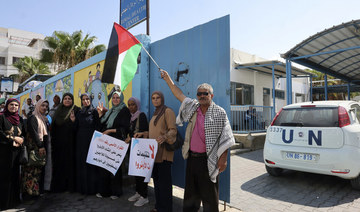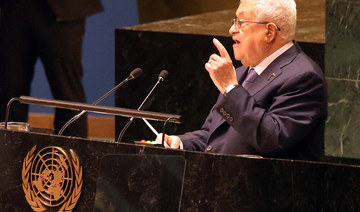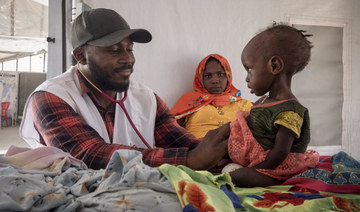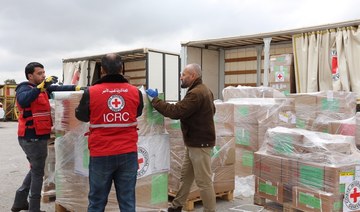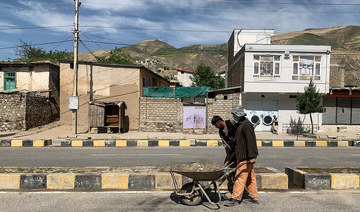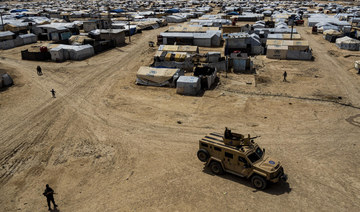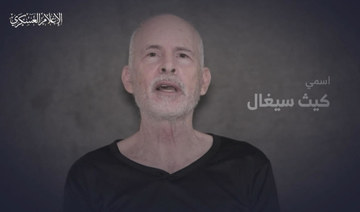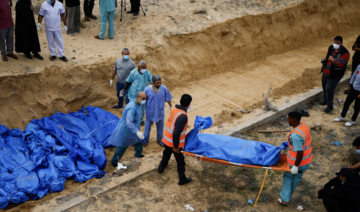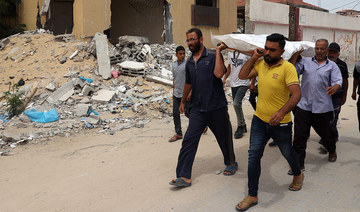JERUSALEM: Israel carried out a series of airstrikes in the Gaza Strip late on Friday after Palestinian activists launched incendiary balloons into Israel as a week of violence along the volatile frontier intensified.
The rising tensions along Israel’s front with Gaza came as fighting in the occupied West Bank surged — to levels unseen in two decades. In the latest bloodshed Friday, the Israeli army killed a Palestinian militant in the northern West Bank.
Palestinian activists have been protesting for the past week next to the fence separating Gaza and Israel. The protests have turned violent, with demonstrators hurling explosives toward Israeli troops, and soldiers responding with tear gas and live fire.
For the first time in the current round of unrest, Palestinian protesters on Friday launched balloons into Israel, blackening large patches of vegetation on the other side of the border. Palestinian health officials said Israeli fire wounded 28 Palestinians during protests along the barrier. Hamas, the militant group ruling Gaza since 2007, says youths have organized the protests in response to Israeli provocations.
Unrest over the past week has escalated tensions and prompted Israel to bar entry to thousands of Palestinian laborers from the impoverished enclave.
Palestinians in Gaza have launched balloons in the past to protest an Israeli-Egyptian blockade imposed on the territory since 2007. The balloons have caused fires and scorched Israeli farmland, prompting Israel on several occasions to use fighter jets to strike at Hamas.
The evening airstrikes struck three military posts belonging to Hamas, the army said. Israel and Hamas have fought four wars and engaged in numerous smaller battles since Hamas took over the territory.
Palestinian protesters at the border fence on Friday said they were demonstrating against recent Jewish visits to a disputed holy site in the Old City of Jerusalem. Jews revere the hilltop compound as the Temple Mount, home to the biblical Jewish Temples. Today, it is home to the Al-Aqsa Mosque compound.
Under longstanding arrangements, Jews are allowed to visit the site, but not to pray there. But growing numbers of visits — along with scenes of some Jews quietly praying — have raised Palestinian fears that Israel is plotting to divide or take over the site. Israel says it is committed to the longstanding status quo.
Earlier Friday, Israeli forces killed a Palestinian militant in the northern West Bank, Palestinian authorities said. The Islamic Jihad militant group claimed the man as its fighter and identified him as 18-year-old Abdallah Abu Hasan.
The Palestinian Health Ministry said Hasan was shot in the abdomen by Israeli forces early Friday morning in a Palestinian village north of the West Bank city of Jenin.
The Israeli army said the shooting occurred during a nighttime raid in Kafr Dan, a town near the militant stronghold of Jenin. It said Palestinians fired at soldiers and threw explosives. Soldiers shot back, hitting Hasan.
The operation was the most recent in a series of stepped-up raids Israel has been staging in Palestinian areas of the West Bank. Israel claims such raids root out militancy and thwart future attacks.
But Palestinians say the raids entrench Israel’s 56-year occupation over the West Bank. The raids, which have been escalated over the past year and a half, also show little sign of slowing the fighting.
Some 190 Palestinians have been killed in the West Bank since the start of the year, according to a tally by The Associated Press. Israel says most of those killed have been militants, but youths protesting the incursions and others not involved in the confrontations have also been killed.
At least 31 people have been killed in Palestinian attacks against Israelis since the beginning of 2023.
Israel captured the West Bank, east Jerusalem and the Gaza Strip in the 1967 Mideast war. The Palestinians seek those territories for their hoped-for independent state.
Israel strikes Gaza after Palestinians in besieged strip launch incendiary balloons toward Israel
https://arab.news/vyvrj
Israel strikes Gaza after Palestinians in besieged strip launch incendiary balloons toward Israel
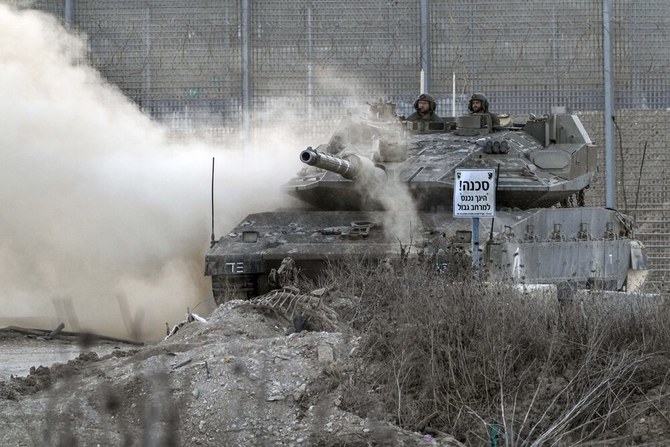
- For the first time in the current round of unrest, Palestinian protesters on Friday launched balloons into Israel, blackening large patches of vegetation on the other side of the border
- Hamas, the militant group ruling Gaza since 2007, says youths have organized the protests in response to Israeli provocations
Fighting with 'heavy weaponry' in Sudan's El-Fasher: UN

- The United States last month warned of a looming rebel military offensive on the city, a humanitarian hub that appears to be at the center of a newly opening front in the country’s civil war
PORT SUDAN: A senior UN official expressed concern late Saturday at reports that heavy weapons were being used in fighting in the Sudanese city of El-Fashur.
Wounded civilians were being rushed to hospital and civilians were trying to flee the fighting in the Darfur region, said a statement from Clementine Nkweta-Salami, the UN’s humanitarian coordinator for Sudan.
“I am gravely concerned by the eruption of clashes in (El-Fashur) despite repeated calls to parties to the conflict to refrain from attacking the city,” said Nkweta-Salami.
“I reiterate — the violence threatens the lives of over 800,000 civilians” who live in the city.
“I am equally disturbed by reports of the use of heavy weaponry and attacks in highly populated areas in the city center and the outskirts of (El-Fashur), resulting in multiple casualties,” she added.
The United States last month warned of a looming rebel military offensive on the city, a humanitarian hub that appears to be at the center of a newly opening front in the country’s civil war.
Tunisian police arrest prominent lawyer critical of president

- Dozens of lawyers took to the streets in protest on Saturday night, carrying banners reading “Our profession will not kneel” and “We will continue the struggle” Saied came to power in free elections in 2019
TUNIS: Tunisian police stormed the building of the Deanship of Lawyers on Saturday and arrested Sonia Dahmani, a lawyer known for her fierce criticism of President Kais Saied, and then arrested two journalists who witnessed the confrontation, a journalists’ syndicate said.
Two IFM radio journalists, Mourad Zghidi and Borhen Bsaiss, were arrested, an official in the country’s main journalists’ syndicate told Reuters. The incident was the latest in a series of arrests and investigations targeting activists, journalists and civil society groups critical of Saied and the government. The move reinforces opponents’ fears of an increasingly authoritarian government ahead of presidential elections expected later this year.
Dahmani was arrested after she said on a television program this week that Tunisia is a country where life is not pleasant. She was commenting on a speech by Saied, who said there was a conspiracy to push thousands of undocumented migrants from Sub-Saharan countries to stay in Tunisia. Dahmani was called before a judge on Wednesday on suspicion of spreading rumors and attacking public security following her comments, but she asked for postponement of the investigation.
The judge rejected her request. Dozens of lawyers took to the streets in protest on Saturday night, carrying banners reading “Our profession will not kneel” and “We will continue the struggle” Saied came to power in free elections in 2019. Two years later he seized additional powers when he shut down the elected parliament and moved to rule by decree before assuming authority over the judiciary.
Since Tunisia’s 2011 revolution, the country has won more press freedoms and is considered one of the more open media environments in the Arab world. Politicians, journalists and unions, however, say that freedom of the press faces a serious threat under the rule of Saied. The president has rejected the accusations and said he will not become a dictator.
SDF hands over 2 Daesh members suspected in 2014 mass killing of Iraqi troops

- Iraq has, over the past several years, put on trial and later executed dozens of Daesh members over their involvement in the Speicher massacre
BEIRUT: Syria’s US-backed Kurdish-led force has handed over to Baghdad two Daesh militants suspected of involvement in mass killings of Iraqi soldiers in 2014, a war monitor said.
The report by the Syrian Observatory for Human Rights came a day after the Iraqi National Intelligence Service said it had brought back to the country three Daesh members from outside Iraq. The intelligence service did not provide more details.
Daesh captured an estimated 1,700 Iraqi soldiers after seizing Saddam Hussein‘s hometown of Tikrit in 2014. The soldiers were trying to flee from nearby Camp Speicher, a former US base.
BACKGROUND
Daesh captured an estimated 1,700 Iraqi soldiers after seizing Saddam Hussein‘s hometown of Tikrit in 2014.
Shortly after taking Tikrit, Daesh posted graphic images of Daesh militants shooting and killing the soldiers.
Farhad Shami, a spokesman for the Kurdish-led Syrian Democratic Forces, said the US-backed force handed over two Daesh members to Iraq.
It was not immediately clear where Iraqi authorities brought the third suspect from.
The 2014 killings, known as the Speicher massacre, sparked outrage across Iraq and partially fueled the mobilization of militias in the fight against Daesh.
Iraq has, over the past several years, put on trial and later executed dozens of Daesh members over their involvement in the Speicher massacre.
The Observatory said the two Daesh members were among 20 captured recently in a joint operation with the US-led coalition in the northern Syrian city of Raqqa, once the capital of Daesh’s self-declared caliphate.
Despite their defeat in Iraq in 2017 and in Syria in March 2019, the extremist sleeper cells are still active and have been carrying out deadly attacks against SDF and Syrian government forces.
Shami said a car rigged with explosives and driven by a suicide attacker tried on Friday night to storm a military checkpoint for the Deir El-Zour Military Council. This Arab majority faction is part of the SDF in the eastern Syrian village of Shuheil.
Shami said that when the guards tried to stop the car, the attacker blew himself up, killing three US-backed fighters.
No one immediately claimed responsibility for the attack, but it was similar to previous explosions carried out by IS militants.
The SDF is holding over 10,000 captured Daesh fighters in around two dozen detention facilities, including 2,000 foreigners whose home countries have refused to repatriate them.
Protesters return to streets across Israel, demanding hostage release

- Family members of the hostages, carrying pictures of their loved ones still in captivity, joined the crowds that demonstrated in Tel Aviv
TEL AVIV: Thousands of Israelis took to the streets on Saturday demanding that Prime Minister Benjamin Netanyahu’s government do more to secure the release of hostages being held in the Gaza Strip by Islamist group Hamas.
Family members of the hostages, carrying pictures of their loved ones still in captivity, joined the crowds that demonstrated in Tel Aviv.
One of them was Naama Weinberg, whose cousin Itai Svirsky was abducted during Hamas’ Oct. 7 assault on Israeli towns and, according to Israeli authorities, was killed in captivity. In a speech she referenced a video Hamas made public on Saturday, claiming that another of the Israeli captives had died.
“Soon, even those who managed to survive this long will no longer be among the living. They must be saved now,” Weinberg said.
As the evening progressed, some protesters blocked a main highway in the city before being dispersed by police, who used water cannons to push back the crowd. At least three people were arrested.
Hamas’ Oct. 7 attack sparked the devastating war in Gaza, now raging for nearly seven months.
UN Security Council seeks inquiry into mass graves in Gaza

- The UN rights office in late April had called for an independent investigation into reports of mass graves at Al-Shifa and the Nasser Medical Complex in Khan Younis
NEW YORK: The UN Security Council has called for an immediate and independent investigation into mass graves allegedly containing hundreds of bodies near hospitals in Gaza.
In a statement, members of the council expressed their “deep concern over reports of the discovery of mass graves, in and around the Nasser and Al-Shifa medical facilities in Gaza, where several hundred bodies, including women, children and older persons, were buried.”
The members stressed the need for “accountability” for any violations of international law.
They called on investigators to be given “unimpeded access to all locations of mass graves in Gaza to conduct immediate, independent, thorough, comprehensive, transparent and impartial investigations.”
FASTFACT
The World Health Organization said in April that Al-Shifa, in Gaza City, had been reduced to an ‘empty shell,’ with many bodies found in the area.
Hospitals in the Gaza Strip have been repeatedly targeted since the beginning of the Israeli military operation in the Palestinian territory following the October 7 attack on southern Israel by Gaza-based Hamas militants.
The World Health Organization said in April that Al-Shifa, in Gaza City, had been reduced to an “empty shell,” with many bodies found in the area.
The Israeli army has said around 200 Palestinians were killed during its military operations there.
Bodies have reportedly been found buried in two graves in the hospital’s courtyard.
The UN rights office in late April had called for an independent investigation into reports of mass graves at Al-Shifa and the Nasser Medical Complex in Khan Younis.
Gaza officials said at the time that health workers at the Nasser complex had uncovered hundreds of bodies of Palestinians they alleged had been killed and buried by Israeli forces.
Israel’s army has dismissed the claims as “baseless and unfounded.”
The statement on Friday from the Security Council did not say who would conduct the investigations.
But it “reaffirmed the importance of allowing families to know the fate and whereabouts of their missing relatives, consistent with international humanitarian law.”
Israel’s offensive has killed at least 34,943 people in the Gaza Strip, primarily women and children, the Health Ministry in the territory said.



